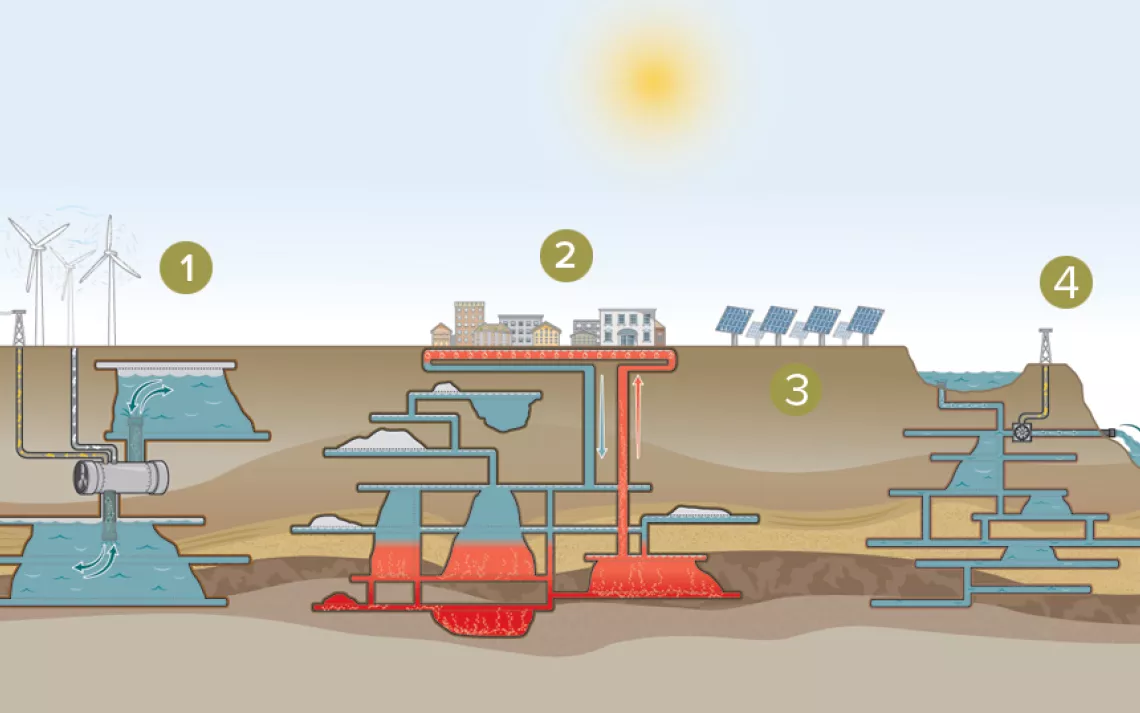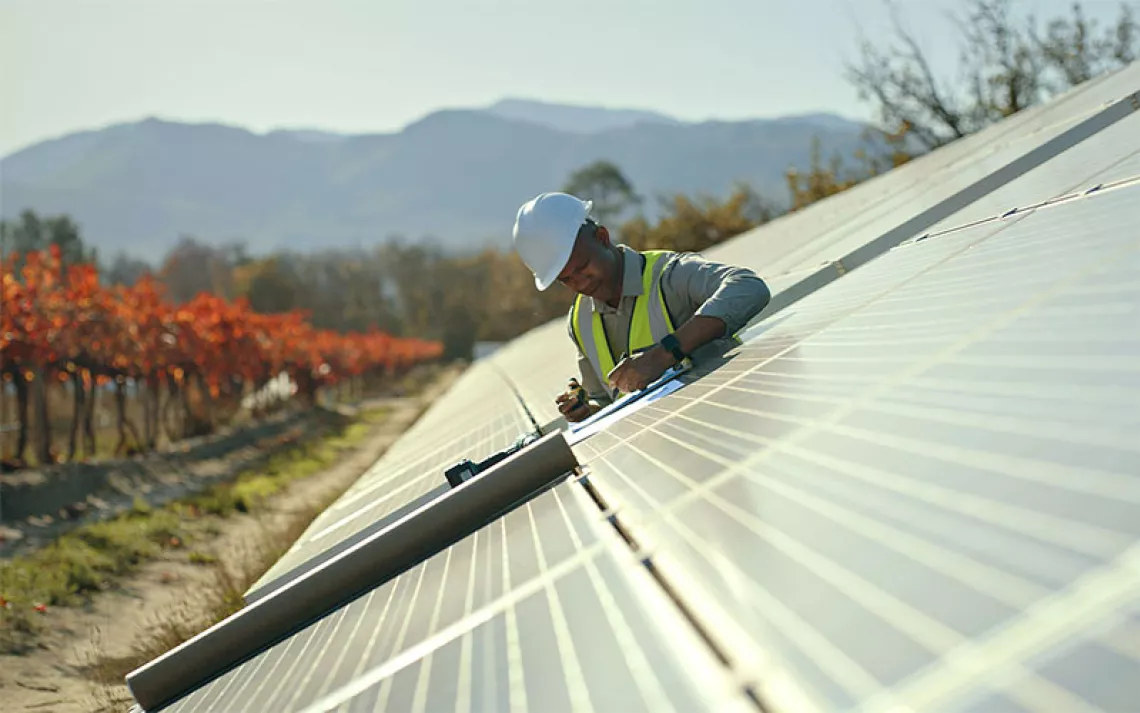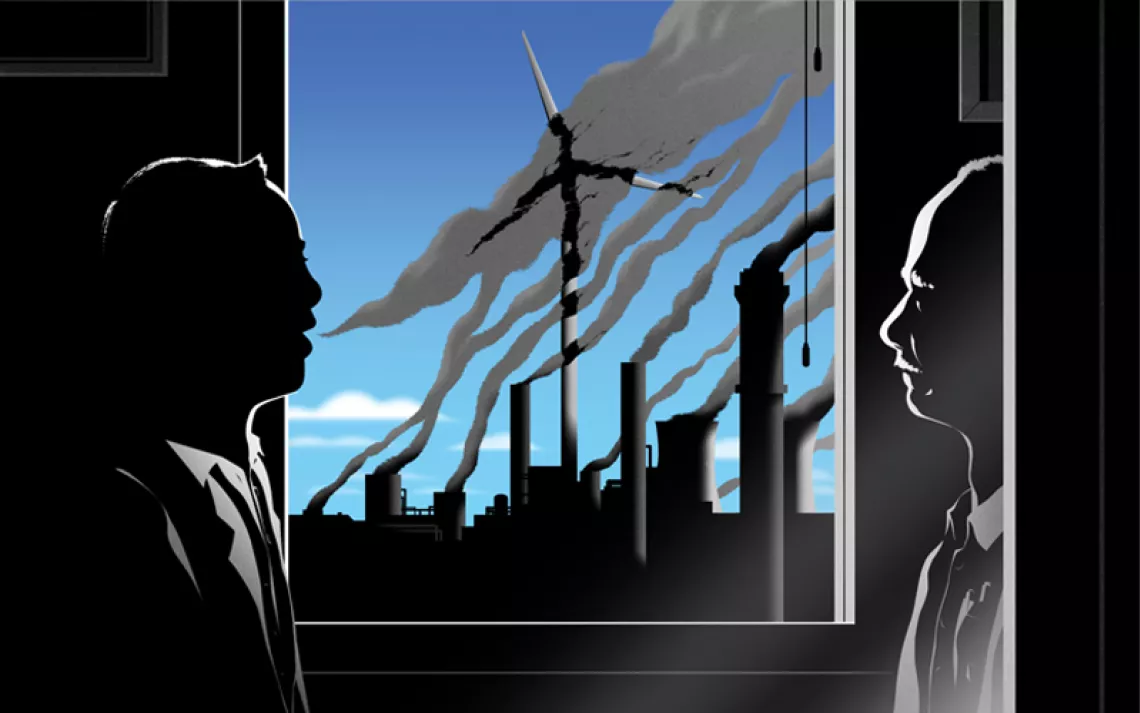Clean Energy From Old mines
Is there a second life for an abandoned mine whose rocky tailings—the pulverized rock left when the valuable ore deposits are gone—can leach poisons like lead and arsenic into waterways for centuries? The United States has 80,000 to 250,000 retired mines wasting away that could be ideal sites for big renewable energy projects. The large, flat expanses surrounding these mines are ready-made for the installation of wind turbines or solar collectors, and the mines' tunnels can serve as hydroelectric reservoirs. The roads to them are already built, and in some cases, power lines that could carry megawatts back to a nearby city are currently in place.

Illustration by Brown Bird Design
- The puzzle of wind power is that it is often strongest at night, when the demand for power is low. Siting a wind farm on top of one of the many played-out lodes in the windy Midwestern plains or the nation's mountainous areas could help solve this problem. Pumped storage uses wind power to shunt water from lower to upper reservoir tanks placed in mine shafts. When power is needed, water can be channeled down through turbines that create electricity on demand. A proposed pumped-storage project in Germany's Harz Mountains would store up to 400 megawatts-hours of energy, enough to power 40,000 homes for a day.
- When coal companies blasted their last in Germany, the United Kingdom, and France, they left behind tunnels thousands of feet deep that have since flooded with water—hot water. At a depth of 2,600 feet, the water is naturally heated to between 86*F and 95°F. That may be too tepid for a shower, but it's warm enough to keep a well-insulated building toasty if the water is circulated through its floors. Alternately, geothermal heat could help reduce the energy boost needed to heat domestic water to a usable temperature. Researchers in Europe are studying how towns and cities could circulate water through a maze of tunnels to help the continent reach its ambitious goals for low-emission power.
- Mines in the desert of the U.S. Southwest are ideal sites for solar harvesters. In Colorado, for example, a uranium mine outside the town of Rifle is now home to two solar arrays that between them generate 2.3 megawatts of electricity—providing more than half the power needed to run the city's new wastewater treatment plant (also on the site) and all the power used to pump water for residents from the neighboring Colorado River. Outside Questa, New Mexico, a former molybdenum mine sports 175 concentrated-solar panels that create a megawatt of electricity, enough to power 500 to 600 homes.
- Mines are often sited near rivers because pressurized water is used to break apart rock, but those rivers can be poisoned by the heavy metals that leach from the fractured stone. At the old Summitville gold mine in Colorado, now a Superfund site, a wastewater treatment plant prevents metals from aluminum to zinc from creeping into the Alamosa River. In 2011, engineers took advantage of the elevation drop in the river and built a 35-kilowatt hydroelectric dam that supplies up to 20 percent of the treatment plant's power. A hydro project that will tap a mine drainage tunnel is being considered for the Jeddo coal mine site in Pennsylvania.
Waiting for a Better Boom
 When Nathan Lindquist arrived in Rifle, Colorado, in 2007, housing was nearly impossible to find. A natural gas energy boom was under way, and workers were pouring into the mountain town in search of a quick buck.
When Nathan Lindquist arrived in Rifle, Colorado, in 2007, housing was nearly impossible to find. A natural gas energy boom was under way, and workers were pouring into the mountain town in search of a quick buck.
The next year, the recession hit and plunged Rifle into a bust. Similar booms for oil shale had whipsawed the town's economy in the 1920s, the '50s, and the early '80s. "The economy here has always been based on some sort of energy extract or another," Lindquist says.
Lindquist, 33, had come for a job with the city's four-person planning department. In 2008, the planners struck on a scheme that might get Rifle off the fossil fuel roller coaster: They turned their attention to a parcel of land on the west side of town by the railroad tracks.
For 80 years, the New Rifle mill had pulverized rocks in search of vanadium (for use in steelmaking) and uranium (for bombs and nuclear power plants). But in 2005, after the radioactive tailings had been trucked off, it became empty property owned by the city. In 2009, two giant arrays of solar panels were switched on at the site. They produce 2.3 megawatts of electricity, helping to power a new wastewater treatment plant and pump station. What else, Lindquist and his colleagues wondered, could be built on the remaining 150 acres?
Soon, they came up with a plan for Energy Innovation Center, a site reserved for biofuel, hydrogen, geothermal, and solar projects. "We're going to diversify our economy, diversify our energy usage," says Lindquist, who was recently promoted to planning director. "We want to create synergistic waste streams and do things locally."
The only tenant so far is Colorado Mountain College, which is tinkering with turning wild grasses into butanol. But Lindquist remains hopeful that more tenants will come, because the site is on a rail line and, most important, is flat. "This is the best staging ground for freight anywhere between Denver and Salt Lake City," he says, with a bit of gold rush excitement in his voice.
This article was funded by the Sierra Club's Beyond Coal campaign.
This article has been corrected.
 The Magazine of The Sierra Club
The Magazine of The Sierra Club







